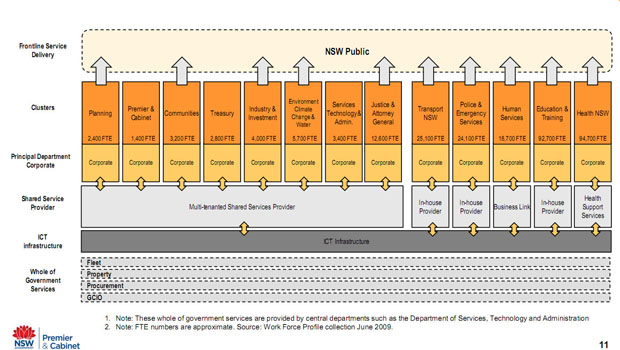NSW govt shared services blueprint released

A recent blueprint for corporate and shared services published by the New South Wales Government has steered away from a one-size-fits-all model, leaving the critical departments of health, transport and emergency services out of any shared service provider arrangement.

The layout of the future NSW IT operating model (Credit: NSW Department of Premier & Cabinet)
According to the document (PDF), the blueprint aims to "provide sector-wide consistency and standardisation within the areas of Corporate and Shared Services while acknowledging the uniqueness and complexity of individual departments and the services they provide".
Following the consolidation of NSW government departments into 13 super-agencies under former New South Wales Premier Nathan Rees, the future model laid out in the blueprint would see the departments of Planning; Premier & Cabinet; Communities; Treasury; Industry & Investment; Environment, Climate Change & Water; Services Technology & Admin; and Justice & Attorney General fall under a multi-tenanted shared services provider. While the more front-line government agencies of Transport NSW, Police & Emergency Services, Human Services, Education & Training and Health NSW will each have its own in-house services provider.
However, the departments that fall under the shared services model will not receive services from that provider for their front-line operations, instead only the following functions will be covered by shared services:
- Finance
- Human Resource Management
- Industrial Relations
- Occupational Health & Safety
- Information Technology & Communications
- Contracts & Procurement
- Governance & Risk
- Executive Services
- Records & Knowledge Management
- Properties, Facilities & Fleet Management
- Asset Management
The decision to keep critical departments such as health and emergency services out of the realm of shared services arrangements may help the New South Wales Government avoid the troubles seen by Queensland in managing its own shared services in the Health Department payroll debacle.
In June, Queensland Premier Anna Bligh announced that the government would be moving away from a centralised shared services model for information and communications technology following the release of a damning report from the Auditor-General's Office into the failure of the SAP-based payroll system in Queensland Health.
The New South Wales blueprint takes a three-tiered approach to moving to a shared services model using short-, medium- and long-term goals set out over the next two years. However, the time frames for shared services to be fully implemented will vary in each department. The government aims to have the transition to shared services fully underway by 2012.